Laser welding speed, laser power and material thickness
The relationship between laser welding speed, power, and material thicknessis crucial for determining the quality and efficiency of welding processes.These three factors (welding speed, laser power, and material thickness) areinterdependent and must be optimized to achieve strong, defect-free welds.Understanding how they interact is vital for industries like automotive,aerospace, and manufacturing, where precision and material integrity areparamount.
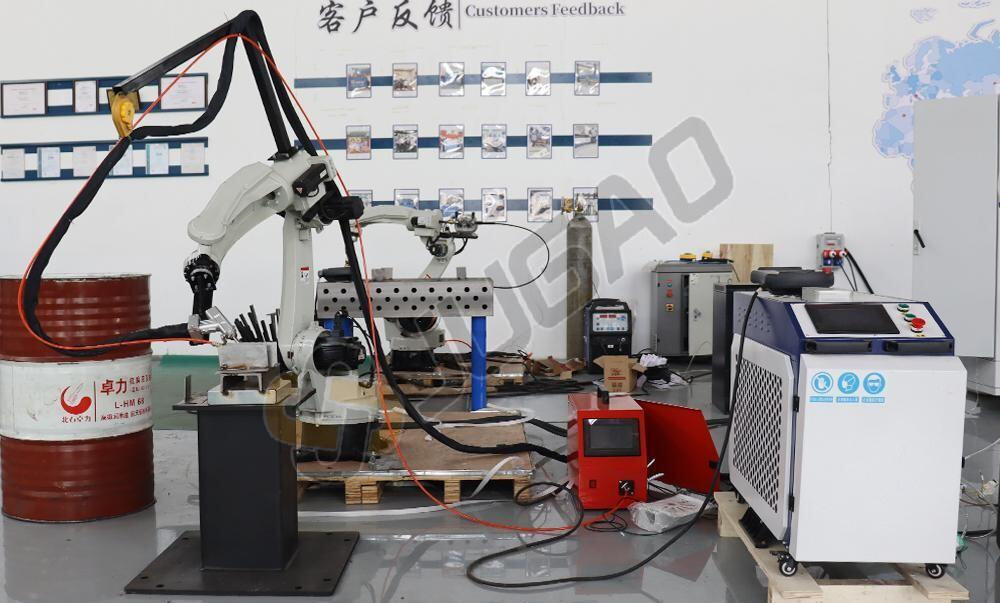
Basic introduction of laser welding machine
Laser welding machine uses high energy laser pulse to local heating of thematerial in a small area, through heat conduction to melt the material, toachieve welding. Its working principle mainly involves the followingaspects:
Optical focus: The laser welding machine uses the laser beam produced bythe laser, through lenses or mirrors and other optical components, to focus thelaser energy on the welding point.
Heat conduction: When the laser beam is irradiated on the surface of theworkpiece, the laser energy is absorbed and converted into heat energy. The heatenergy is gradually transferred along the metal conductive part of the weldingjoint through heat conduction, making its temperature rise.
Melting and mixing: When the metal surface is exposed to a high enoughtemperature, the metal begins to melt and form a molten pool. Under the actionof the laser beam, the molten pool spreads and mixes rapidly to achieve theconnection of the metal joint.
Cooling and solidification: After the laser beam is stopped, the moltenpool gradually cools and forms a welded joint during the solidification process.During the solidification process, metal molecules rearrange and crystallize toform a strong welded connection.
Advantages of laser welding machine
High precision: can achieve micron-level welding accuracy, especiallysuitable for the welding requirements of miniature and complex structures.
Fast speed: Especially in the deep melting welding mode, due to theconcentration of laser energy, the pool is small and deep, resulting in fastwelding speed and high production efficiency.
Small deformation: Compared with traditional welding methods, laser weldinghas lower heat input and less influence on the surrounding material, which isconducive to reducing the deformation after welding.
Small thermal affected zone: can reduce the thermal damage to surroundingmaterials and improve the quality of welded joints.
Laser welding power, speed and material thickness
1. Laser welding power supply
Laser power is the decisive factor in determining weld penetration depth andtotal energy input during welding. It determines the heat required to melt basematerials and form a welding pool. For thicker plates, higher laser power istypically needed to achieve sufficient penetration depth, while thinnermaterials can be protected from excessive melting or burn-through with lowerpower settings.
Higher power: can achieve deeper penetration, suitable for welding thickermaterials. However, if the power on the thin plate is too high, it will lead tosmall hole instability, spatter and even burn through defects.
Reduced power consumption: More suitable for thinner plates, providingbetter control and preventing overheating from causing material deformation ormelting.
The laser power must be carefully selected according to the thickness of thematerial to ensure proper fusion and no defects.
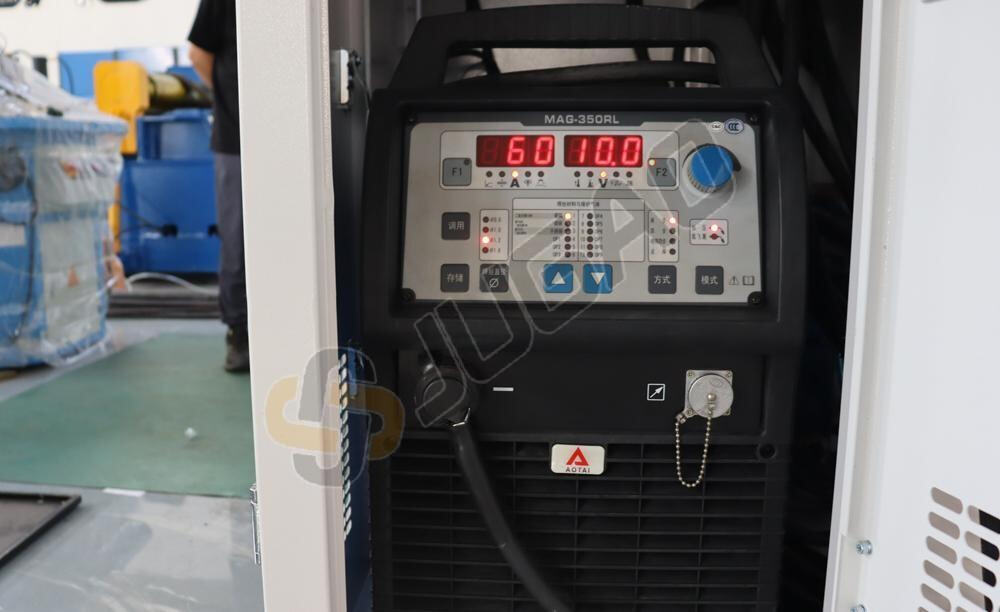
2. Welding speed
Welding speed refers to the rate at which a laser travels along a weldedjoint. It affects heat input per unit length and is a key factor in determiningwelding quality. There is a direct relationship between welding speed and laserpower, as increasing one typically requires adjusting the other to maintaindesired welding performance.
Higher welding speed: Reduces heat input per unit length of welding, whichis beneficial for thin materials and avoids overheating and deformation.However, if the speed is too high for a given power, the weld may lackpenetration, resulting in weak joints or incomplete fusion.
Reduce welding speed: Increase heat input to melt more and penetrate deeperinto the substrate. This is advantageous for thicker plates, but can causeoverheating of thin materials or excessive flow of molten metal.
Using the best welding speed is critical to balance heat input and avoidcommon welding defects (such as porosity, cracking or deformation).
3. Material thickness
The thickness of welding materials plays a crucial role in determiningrequired power and permissible welding speeds. Thicker plates require more heatto achieve full penetration, which means the laser must operate at higher powerlevels and may need to reduce the welding speed to allow sufficient time forheat absorption. Conversely, thinner plates demand less power and higher speedsto prevent excessive heat input that could lead to melting or burn-through.
Thicker plates: More energy is required to achieve full penetration. Thelaser must provide higher power and the welding speed must be slower to transferenough energy to the material.
Thinner plates: Less energy is required, so the laser power can be reducedand the welding speed increased. Thin materials are more prone to heat-relateddeformation, so precise control of these variables is critical.
The interaction between force, speed and thickness
The relationship between laser welding speed, power and sheet thickness is abalancing act. For each thickness of material, there is an optimal combinationof laser power and welding speed to ensure high welding quality, correctpenetration depth and minimal defects.
For example, when welding thick steel plates, increasing laser power withoutadjusting the welding speed may result in excessive heat input, leading todefects such as warping or overly wide weld beads. Conversely, reducing thewelding speed without boosting power could cause welds to become too deep,potentially causing material overheating. For thin materials, excessive powercombined with slow welding speed might lead to over-melting or burn-through ofthe material.
Relationship between laser welding speed and plate thickness
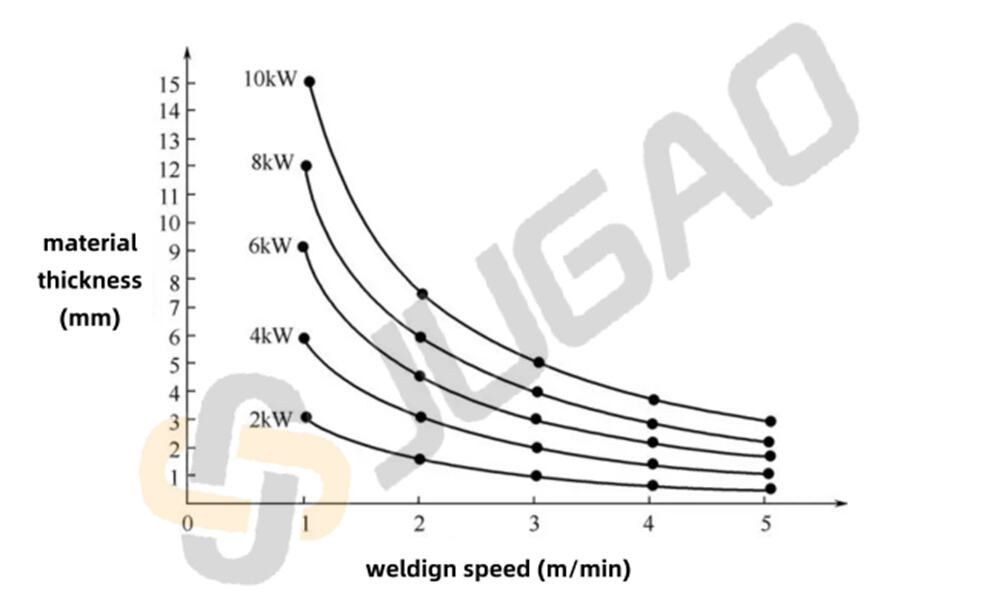
Thick plates require a slower welding speed
When laser welding thicker plates, the material requires more heat to achievecomplete penetration and ensure adequate joint strength. Therefore, it's crucialto reduce the welding speed to allow sufficient time for the laser beam totransfer heat throughout the entire thickness of the material. If the weldingspeed is too fast, the laser energy won't penetrate fully, which may result ininsufficient penetration depth, discontinuous welds, or inadequate jointstrength.
Thick plate (>6mm): The welding speed should be slow to ensure that thelaser energy can fully penetrate the entire thickness of the plate to form astable and high strength weld.
Thin plates can be welded faster
Compared to thick plates, thin sheet materials (less than 2mm) require lessheat, allowing lasers to penetrate the entire thickness more easily. Thisenables faster welding speeds that effectively prevent overheating or excessivemelting, thus avoiding welding deformation or burn-through. Additionally, higherwelding speeds can significantly improve overall efficiency.
Thin plate (<2mm): the welding speed should be fast to reduce thedeformation, burn through and other welding defects caused by materialoverheating.
Effect of laser power on welding speed and plate thickness
Laser power determines the energy input during welding. High-power lasersdeliver stronger heat output, making them ideal for welding thicker materials,while low-power lasers are better suited for thin plates. When selecting weldingspeed, it's crucial to match the laser power with the plate thickness to ensureadequate penetration without causing material overheating.
Thick plate high power laser welding
When welding thicker plates, higher laser power is required to ensuresufficient heat transfer into the material to form a stable molten pool.Combined with a lower welding speed, the laser energy can heat the materialuniformly over a longer period of time to ensure the depth of fusion.
6kW power welding thick plate (10mm): welding speed is usually between0.5-1.2m/min.
Thin plate low power laser welding
In thin plate welding, lower power and faster speeds help prevent overheatingand weld deformation. Typically, when the laser power is in the 2-3kW range,plates less than 2mm thick can be processed.
2kW power welding thin plate (1mm): welding speed is usually between5-10m/min.
Laser welding machine power and speed comparison table
The following is a comparison of laser welding machine power and weldingspeed under different plate thickness conditions:
| Materialthickness (mm) | Laserpower (kW) | Weldingspeed (m/min) |
| 1.0 | 2.0 | 7.0 |
| 2.0 | 3.0 | 4.5 |
| 4.0 | 4.0 | 2.5 |
| 6.0 | 6.0 | 1.2 |
| 8.0 | 8.0 | 0.8 |
| 10.0 | 10.0 | 0.6 |
Thin plate (1-2mm): The combination of low power (2-3kW) and high weldingspeed (5-10 m/min) is suitable for this type of welding, ensuring fast operationwithout excessive heat generation.
Medium and thick plate (4-6mm): medium power (4-6kW) combined with mediumspeed welding (1-3 m/min) can ensure the depth of fusion and avoid excessiveheat affected zone.
Thick plates (>6mm): For thick plates, use high power (8-10kW) combinedwith slow welding (0.5-1 m/min) to ensure that sufficient heat penetrates intothe material and forms a high strength joint.
Laser welding power, thickness and speed chart
Laser welding is a precision joining technology that delivers high-speed,high-quality welding for various metal thicknesses. The relationship betweenlaser power, material thickness, and welding speed is critical to achievingoptimal results. This is a comprehensive chart detailing these parameters forcommon materials.
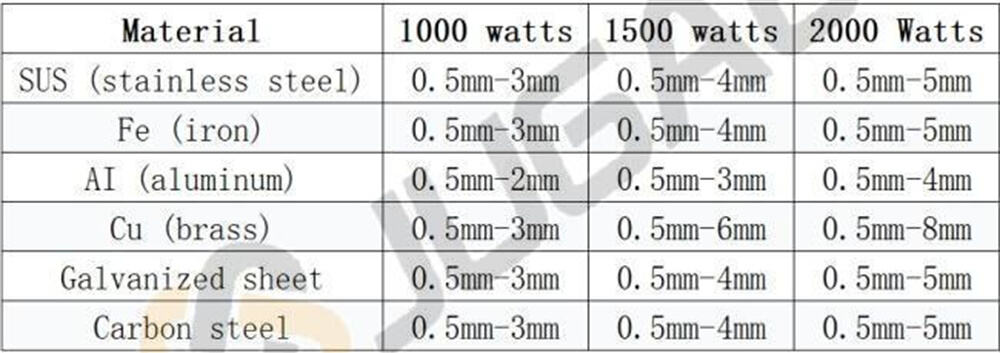
Mild steel

Stainless steel
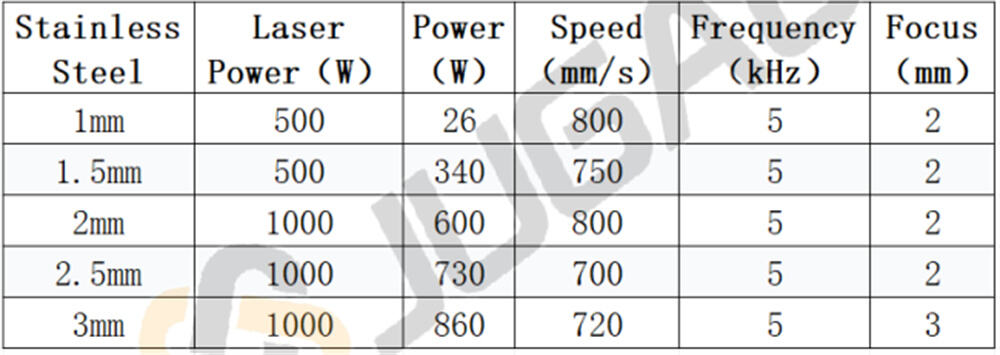
Aluminium

Copper
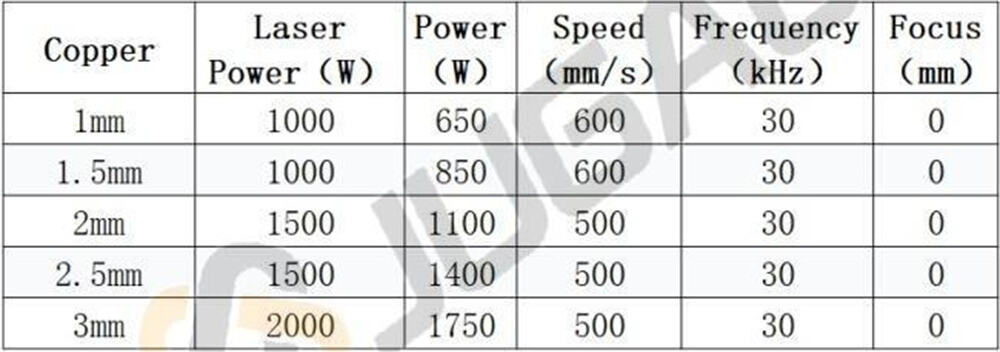
Yellow metal
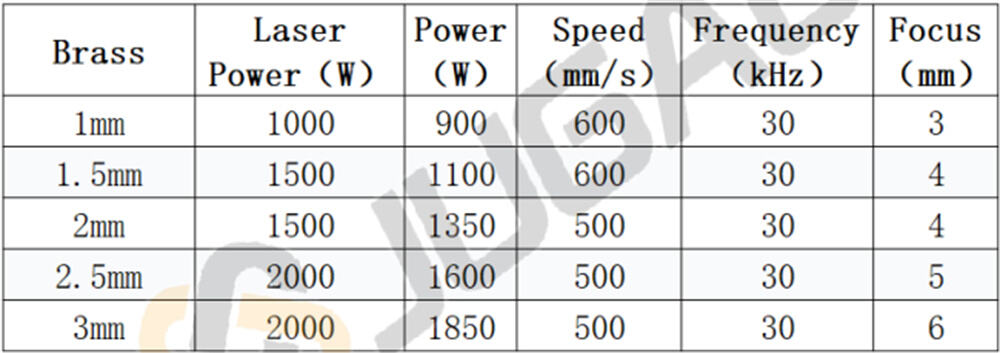
Galvanized sheet
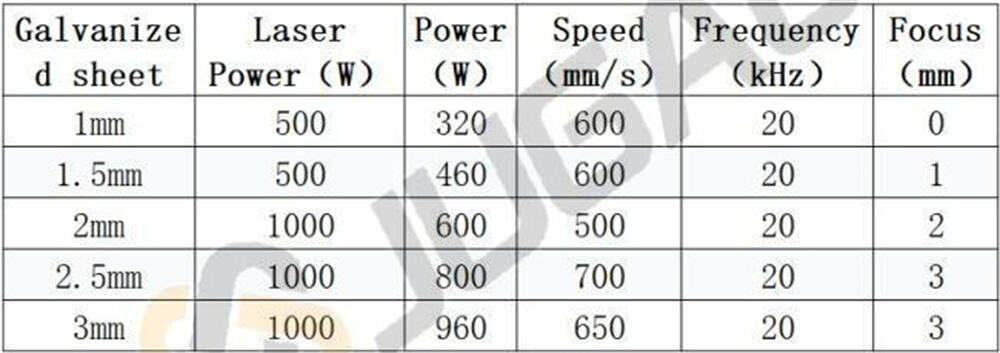
Conclusion
In summary, thicker plates generally require higher power and slower weldingspeeds, while thinner materials need lower power and faster welding speeds. Thisdelicate balance ensures efficient energy utilization and superior weldingquality. Understanding these interrelationships enables manufacturers tooptimize their processes for specific applications, materials, and thicknesses,resulting in stronger, more reliable welds with fewer defects.


















































